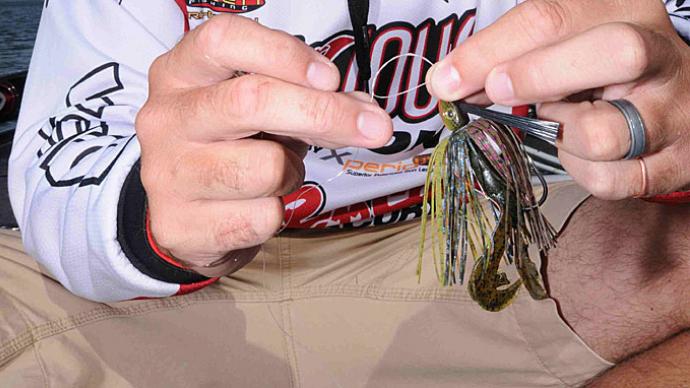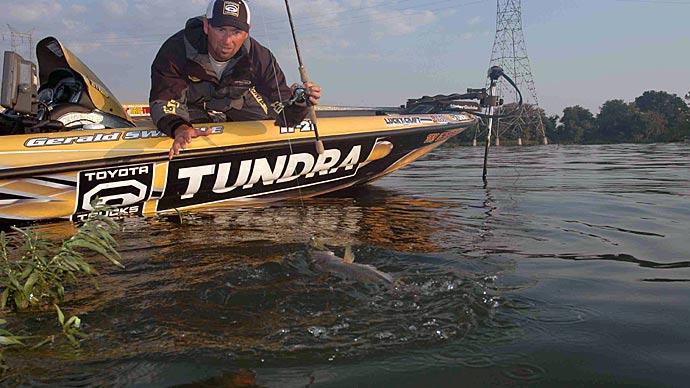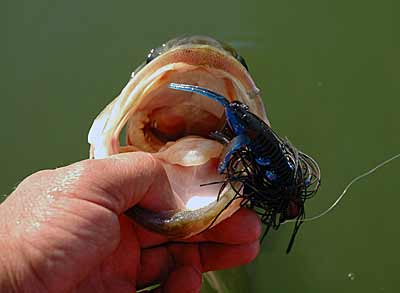
When it comes to swim jigs, they have been on the bass scene for many years running, but they don't get a lot of attention and kind of stay under the radar out of the limelight. Part of this is bass fishermen are reluctant to talk about baits that work until they are pressured to do so, and if they can keep their top baits out of the headlines, they like it that way.
The swim jig falls squarely into this category. Many bass fishermen have a swim jig rod in their rod locker rigged and ready to go but don't lay it out on the boat deck to get noticed by another fisherman until it's needed. Yes, you have a few pro bass fishermen that are the opposite. Ask recent Bassmaster Elite winner Bill Lowen about a swim jig, and he will talk to you all day about it because fishing a swim jig is one of his specialties. In his early years, Bill depended on fishing a swim jig on the Ohio river and used these tough fishing grounds to develop his swim jig knowledge and expertise.
Tom Monsoor is another name that's risen to the top of the swim jig list. I had the privilege to fish against Tom a few times on the Mississippi River in past Redman Tournaments many years ago. His number one bait at that time and still is today was a swim jig. Tom is well known for bringing the swim jig pattern to the light of day for bass fishing. What started as a river secret quickly spread all across bass fishing circles.
Let’s break down the swim jig. There are four main categories when it comes to swim jigs.
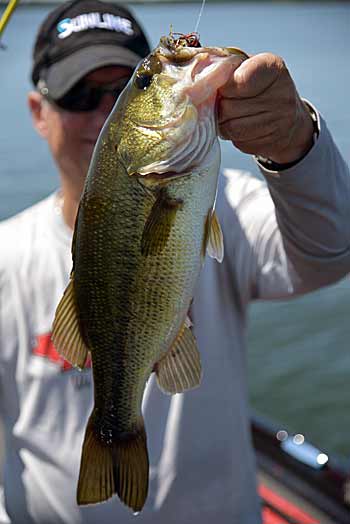
Finesse Swim Jigs: Jig Size 1/4oz to 3/8oz. These swim jigs are often made in lighter sizes and are equipped with a lighter wire hook. Finesse swim jigs are usually rigged with a paired down skirt strand count many times half of the average skirt strand count. This adjustment will give the skirt more movement in the water as there is not as much resistance against the skirt with the reduced number of strands. (Buy now: https://bit.ly/3srYXu6)
The Finesse swim jig is fished on a 7ft medium-action baitcaster with a reel spooled with 12lb-15lb fluorocarbon line. Some fishermen may even still use 12lb to 15lb monofilament as a line choice to keep their swim jig above the weeds. The attraction to using this swim jig is keeping the bait up above the bass higher in the water column to be seen against the sky backdrop.
Standard Swim Jig: Size 1/4oz to 1/2oz. The standard swim jig is the foundation when it comes to swim jigs. It's made with a standard wire jig hook and comes equipped with a fully dressed skirt. Cut the skirt above the hook bend to get the most movement out of this skirt. (Buy now: https://bit.ly/3x1OEQN )
Standard swim jigs are fished on a 7’ MH action baitcaster rod, teamed with a baitcaster reel spooled with 15lb to 20lb fluorocarbon line. You'll also see some fishermen use a 20 to 30lb braided line. Heavier cover situations and water clarity may instill this line switch away from fluorocarbon.
Heavy Swim Jigs or No-Jack Swim Jigs (Dirty Jigs): Jig Size 3/8oz to 3/4oz. These swim jigs are fished in waters where big double-digit weight bass live. These swim jigs are equipped with heavy-duty hooks that won't bend under the stress of braided lines or by the pressure put on by big bass. These swim jigs are equipped with standard skirts, but they are big enough to power the larger jig for trailer choices. (Buy now: )
For this segment, beef up your swim jig equipment and line. 7’3” to 7’6” MH rods teamed with baitcaster reels spooled with 30lb to 50lb braided line.
Craw Swim Jigs: Jig Size 3/8 to 1/2oz. Not many bass fishermen ever mention craw swim jigs because they lump them in with football jigs. In some segments, craw swim jigs that are being used are being fished on Arkie-headed jigs matched with craw imitation color skirts and matched craw trailers. Make your cast, let the jig settle to the bottom, and twitch the jig along the bottom with a stop and go retrieve to imitate a craw trying to get away. (Buy now: https://bit.ly/3q2GX9i )
Craw swim jigs are fished on a 7ft MH baitcaster rod with a baitcaster reel spooled with a 12lb to 15lb fluorocarbon line.
Swim Jig Trailers
Swim jig trailers play a pretty important part in your swim jig makeup as the trailer gives the swim jig its action. At the start of the swim jig adaption, many fishermen used grub trailers as grubs are an excellent choice for a swim jig trailer.
When you take a closer look at the swim jig, there is not any action that is built into the jig. The jig is pointed in the front to go through the weeds better. This design was done on purpose to split the weeds as it swims through them, making them as weedless as possible.
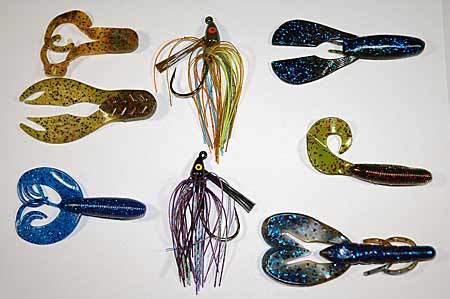
Grub Trailers
You're starting with grub trailers. To imitate a craw or frog, you can pick and use single-tailed grubs or twin-tailed grubs. When picking grub trailers, there is not a lot of action that will be transferred to the jig, so try to keep flash or visible color in mind when picking grub. To put more attraction into the bait, try to oversize your grub tails to give a little more flash or sound into the presentation.
Strike Kings Menace Grubs have an added swimming tail action and sound to the swim jig, making it stand out from other grubs.
Craw Trailers
When looking at craw trailers, you want to bring to light a few factors. Some craws on the market give off a good bit of action. Here are three that I'll put into this category.
- Big Bite Baits Kamikaze Craw - This craw has built-in action as it swims and comes in two sizes covering all your swim jig, 3” and 3.75”. When it comes to color, match the craw to the bait You're trying to imitate. (Buy now: https://bit.ly/3tucGSq )
- Z-Man’s Turbo Crawz – This little 3” Turbo Crawz has a lot of action and is made of Elastic so that it will last a long time on the back of your swim jig. (Buy now: https://bit.ly/3ef4COK )
- Strike Kings Rage Craw- The Rage Craw has action and gives off vibration to help attract the bass to your swim jig in the process. The Rage Craw comes in many different colors and a few different variations, so give this trailer a look. (Buy now: https://bit.ly/3rsdtSs )
Creature Baits
Many of the creature baits on the market don't offer a large amount of action when it comes to the craws, but the one thing that they do offer is bulk. I often rig my swim jig with a creature bait when I'm trying to slow down my retrieve speed and keep it above the cover that I'm fishing. The key here is to undersize your jig and bulk up your swim jig with a creature bait.
Swimbaits

Swimbaits will impart the most action into your swim jig of all the trailer choices, and that is why a swimbait is often the number one swim jig trailer choice. The best way to grade different swimbaits action is to put the swimbait on a jig head and swim the bait close to the boat or stand on a dock and grade each bait. Different swimbaits will have different swimming and rolling motion as it swims. This swimming action will often change as size upgrades, so make sure you test all sizes that you intend to use.
You may not get a distinct rolling action in some smaller sizes as the swimbait swims, but there will be enough action to add motion into the swim jig skirt. This pulsing movement from the skirt triggers bites in the smaller swim jigs, so make sure that you look for this action in the smaller swimbaits.
Swim Jig Skirt Colors
When it comes to picking skirt colors, the first rule is to match what you're trying to imitate. Match the hatch is called, so look at the forage in your water and make sure you have these colors in your skirt. Other swim jig fishermen ask what color spinnerbait or Chatterbait color would you throw. Make sure to match your swim jigs to these colors as well. Color is an open experiment. I know one color all swim jig fishermen have stocked and carry. Black and blue is a must-have.
How To Fish Your Swim Jig
The best way to describe how to fish your swim jig is precisely how you would fish a spinnerbait or chatterbait. It's said by many that swim jigs are the finesse version of these baits. My swim jig key is making your cast and, on the way, back to the boat, try to make your swim jig contact with every piece of cover you can. The more cover you can hit, the more bites you'll get.
Some fishermen like to jiggle their rod while swimming the jig back. I have tried this retrieve without any results, so I have kind of put that to the wayside. Another thing that I pay attention to there is any targets that I can drop my bait alongside as I'm bringing it back to the boat. I have taken many good bass by stopping and dropping my swim jig alongside key cover like stumps, rocks, and dock posts as I was swimming it back to the boat.
Swim jigs can be used and fished in different water types and conditions. They are a viable tactic in your arsenal when on the water. Take advantage of that and make sure that you have in your boat what is needed, and don't be shy to get in your swim jig time. You'll soon learn how good swim jigs are and why other bass fishermen keep this bass catching tactic on the down-low.



